LOCATION: Connected Ulaanbaatar by 360 km asphalt road, on the east bank of the Orkhon River in Kharkhorin town, Uvurkhangai province.
One of the top central Mongolia attractions, Erdenezuu Monastery is a part of the Orkhon Valley World Heritage Site by UNESCO.
The monastery was built on the site of the Great Mongol Empire capital Kharakhorum using some of the building materials of the ruined city.
Started building in 1586 by Khalkha Mongolian ruler Abtai Sain Khan’s order, it is the oldest, as well as the largest Buddhist monastery in Mongolia.
400m by 400 m fortress wall surround the monastery – the wall bears evenly spaced 25 white stupas on each side, and two additional ones at each corner, totaling 108. Although several are currently damaged or missing. 108 is a sacred Buddhist number.
The surrounding stupas were built 200 years after the foundation of the monastery by the fund of alm givers and worshippers of Buddha. Each wall has a large gate at the midpoint.
At its peak, the monastery had 62 temples, around 500 gers inside the walls, and 1000 monks in residence.
The monastery was ransacked and damaged several times.
Oirat Mongolian ruler Galdan ransacked the monastery in 1688 when he was invading after Zanabazar, a religious leader of the time. Again, devastated by Galdan’s nephew Tseren in 1732.
The monastery was both abandoned and refurbished in between.
Later, the monastery was partially destroyed by the communists in 1937. The government protected the monastery between 1940 and 1965, then transformed into a museum in 1965 with no monks in residence. The religious activities again began in 1990 after the collapse of communism. In 1997, the governors decided to restore the monastery, although most of it functions as a museum.
Today, the monastery comprises of 3 large temples, one Tibetian style active temple, a big ger temple, stupas, wall enclosure, some other small temples, and buildings.
The 3 large temples along with other small temples located in the same courtyard, serve as a museum displaying some of the most precious Mongolian artifacts of 16th to 19th-century Buddhist masters.
You also see stone figures and monuments of the different historical periods within the monastery wall and nearby.
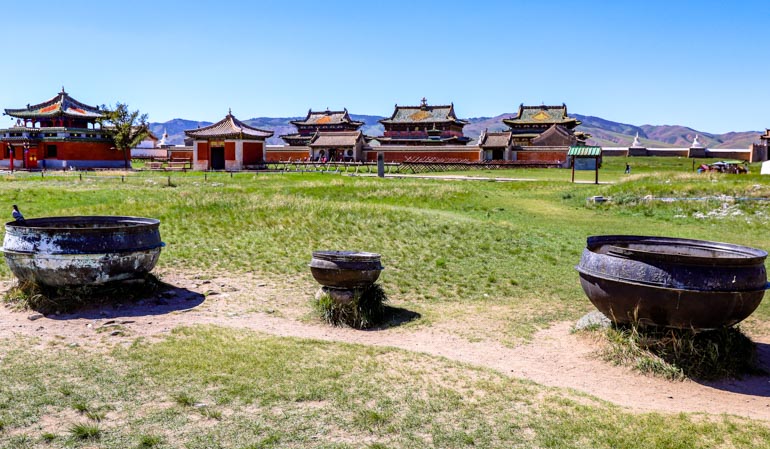
LOCATION: 520 km from Ulaanbaatar, 70 km from Bat-Ulzii town of Uvurkhangai province.
There are 8 beautiful lakes of different sizes at an altitude of 2400 m above sea level, among the Khangai Mountain Range.
Volcanic eruptions formed the Eight Lakes or Khuisiin Naiman Nuur. These scenic lakes are accessible on horseback or hiking from the northern side. The Eight Lakes are called Shireet, Mukhar, Khaliut, Bugat, Khaya, Duruu, Khuis, and Onon located 500 m to 3 km from each other.
The area is beautiful, surrounded by coniferous tree-covered mountains and multitudes of wildflowers dot the forest clearings. It is a famous horse-riding destination in central Mongolia.
Shireet lake is the largest among the Eight Lakes and is accessible by sturdy 4WD from the southern side.
Eight Lakes weather is relatively cool in summer with an average temperature of +20°C day time and +15°C at night. It is advisable to bring fly spray both for the hikers and horse riders as the grassy area attract flies.

LOCATION: 280 km southwest of Ulaanbaatar and 80 km northeast of Kharkhorin.
84390-hectares of Khogno Tarni National Park designated to protect taiga, steppe, and semi-desert plants and the ecosystem. The Khogno Tarni National Park features different natural zones and sceneries such as rugged Khogno Khan Mountain with its pine and birch covered valleys, mountain steppes, hilly steppes, grasslands, and semi-desert, including 80 km long Mongol sand dunes.
The majestic Khogno Tarni Mountain is a great hiking area, except it also houses ruins of ancient monasteries.
Both the mountain and surrounding grassy steppes are ideal for a horseback adventure.
Visitors ride camels, see and experience Mongolian semi-desert not traveling to the remote Gobi desert.
Ikh Mongol Mountain in Khogno Tarni National Park marks the central point of Mongolia. The first foundation of the capital city Ulaanbaatar was established in the south of Ikh Mongol Mountain, followed by 28 times movement until it settled the present-day location.
The Ulaanbaatar-Kharkhorin main road runs through the national park.
There are several tourist ger camps, nomad families run guest gers, and nomadic families stay available.

LOCATION: 420 km from Ulaanbaatar, 60 km west of Kharkhorin, and 20 km northeast of Bat-Ulzit soum, Uvurkhangai province.
Built on the rocky top of Shiveet Ulaan mountain, Tovkhon Monastery allows both visitors and pilgrims to enjoy wild nature and panoramic views of the surrounding area.
Tovkhon is one of the oldest Buddhist Monasteries in Mongolia and a famous pilgrimage center.
Its first temple was built in 1653 as a meditation and creation temple for Zanabazar, the first Bogd Gegeen (religious title), leader of Mongolian Buddhism, sculptor, and painter, who lived and worked in the monastery for over 30 years creating his famous artworks and invented Soyombo script. The first letter of the Soyombo script is the national symbol of Mongolia that could found on the Mongolian flag and many other official documents.
The monastery had 14 temples. However, most of the temples destroyed in 1688 by Oirat Mongols during their military campaign against Khalkha Mongols. However, it was restored in 1773 before another destruction during the communist purge in 1939. Religious activities at the monastery restarted in 1992 after the start of the restoration in 1990, which continued until 1997.
The Tovkhon Monastery is a part of the Orkhon River Valley UNESCO World Cultural Heritage Site.
The monastery is accessible both from the eastern slope and western slope of the mountain. A return hiking takes 2.5 hours through scenic trails of coniferous tree-covered mountain, plus some sightseeing time.
A sturdy 4WD can drive the steep road up about 20 min, or you could hire a horse.
Though, hiking to the monastery is the best and the safest way.
There is a family-run small ger camp near the monastery.
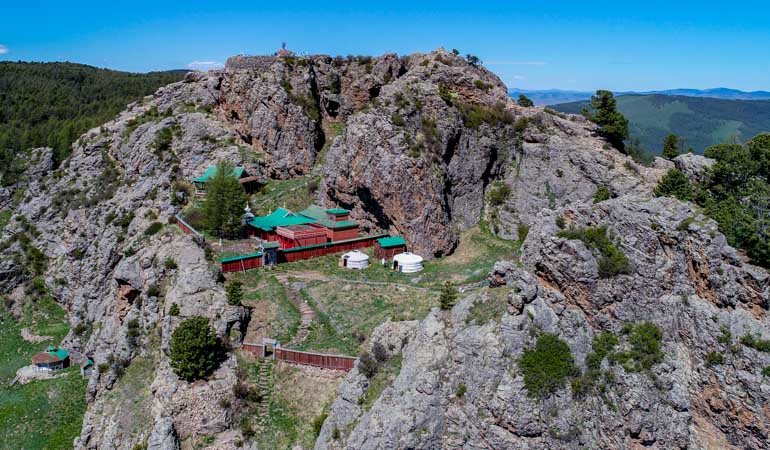
LOCATION: 100 km southwest of the capital Ulaanbaatar.
The 50,000 hectares of the area of Hustai National Park comprises serene hills, steppes, and mountains.
Hustai protected area was established in 1993 after the first successful reintroduction of 15 wild horses or Przewalski horses/Takhi horses in their wild homeland in 1992 by the initiation of the Holland-Mongolian joint project followed by more transports from foreign countries, reached a total number of 84 heads.
The reintroduction and conservation in Hustai National Park was a success. At present, 350 wild horses are roaming in the wild.
The wild horse name Przewalski came after Russian Geographer (Polish origin) Nikolay Przhevalsky, who first discovered the wild horse during his central Asian research in 1878.
They are the only still-living wild ancestor of the domestic horses.
Those horses became extinct in the wild by the end of the 1960s. Human population expansions to their land, overhunting sometimes for food, poaching, drought or rainless summer, and severe winter were some of the reasons for the wild horse extinction. Anyway, there were some Takhi horses in the captive zoos and private collections of individuals in the western countries.
Except for the wild horses, Hustai National Park is home to 459 species of vascular plants, 85 species of lichens, 90 species of moss, 33 species of mushrooms, 44 species of mammals, 217 species of birds, 16 species of fish, 2 species of amphibians, and 385 species of insects.
The Przewalski horse is not just a wild horse. They are genetically different from the domesticated horses, with 2 extra chromosomes. The wild horse has 66 chromosomes, but the domestic horse has 64 chromosomes.
Besides the wildlife and landscape, Hustai National Park also protects conservation values of historic significance. There are deer stones, burial sites, and stone carvings ranging in time from the Bronze Age to the 6-8th century Turkic Khaganate. Among the historical features, Turkic Khaganate Ungut monuments are spectacular as it has the most numerous collections of stone figures in central Asia. The location of Ungut monument is 38 km from Hustai ger camps.
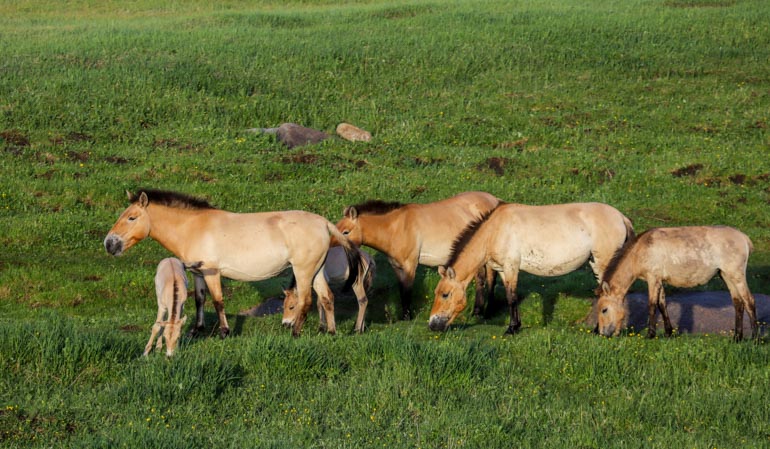
LOCATION: Connected Ulaanbaatar by 54 km paved roads.
This 40 m tall equine statue of Genghis Khan is the largest statue of an equestrian in the world.
They choose to build the statue at Tsonjin Boldog according to the legend that Genghis Khan found a whip in this area. In Mongolia, people believe that man finding a whip is a sign of fortune, good destiny, and occasion.
The statue faces east, the direction of Genghis Khan’s birthplace, and the sunrise. If you stretch your eyes to the east, you will see a small statue of his mother greeting him.
The statue location is an ideal day trip distance away from Ulaanbaatar. Combining the statue with a visit to the Gorkhi Terelj National Park will be a good idea.
Inside the statue, you will tour the numerous portraits of the Khan lineage, see the evolution of the traditional nomadic dwelling gers, try on traditional Mongolian costumes for photos, visit souvenir shops or dine in a restaurant on the second floor.
The visitors take an elevator and walk to the horse head area through its chest and neck to the observation deck where you look out on panoramic views of the Tuul River Valley and Khan Khentii Mountains, the birthplace of the khan.
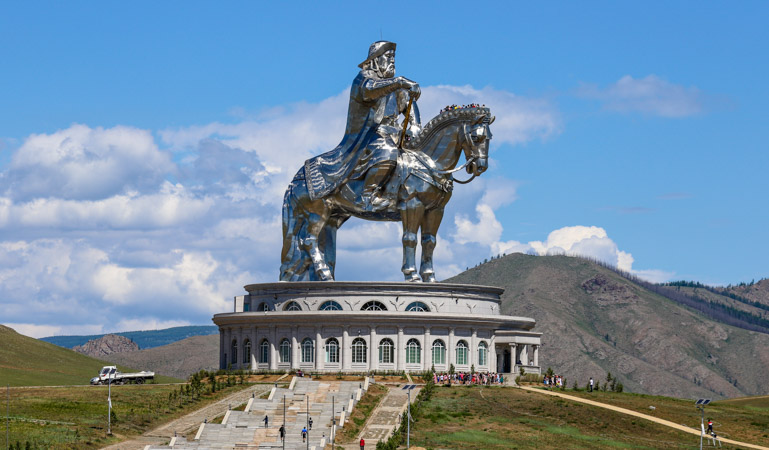
LOCATION: 65 km northeast of Ulaanbaatar by paved road.
The Gobrkhi Terelj National Park is renowned for its majestic granite stone mountains, spectacular formations, and picturesque valleys.
This national park is famous for the short period visitors to Mongolia, weekenders, and day travelers.
Numerous ger camps, resorts, and hotels of all categories dot its valleys.
Recommended activities and attractions of Gorkhi Terelj National Park are: see the legendary Turtle Rock, hiking, horse riding, yak/ox cart tour, temple visit, nomad family visit, nomadic dwelling ger stay, try archery and dog sledding, ATV and snowmobile ride in winter.
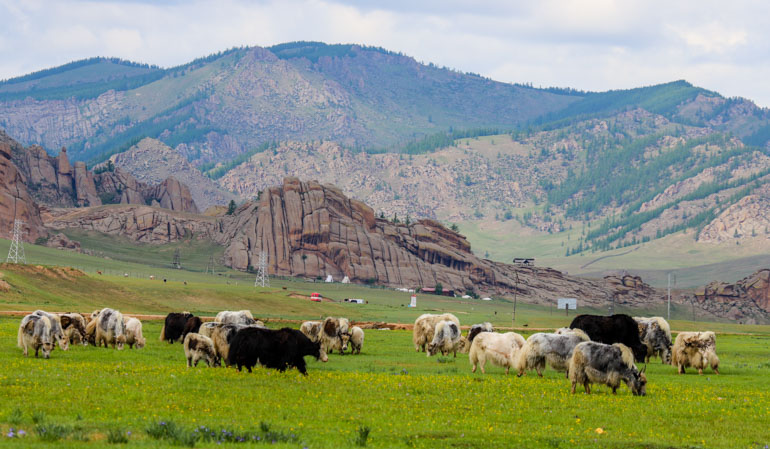
LOCATION: 495 km from Ulaanbaatar, 30 km northeast of Bat-Ulziit town, Uvurkhangai province.
The waterfall falls from 24 m lava cliffs on the junction of Ulaan River confluence to the Orkhon River. Therefore, the waterfall is called different such as Ulaantsutgalan or Orkhon Waterfall, or Orkhonii Khurkheree.
The Ulaan Tsutgalan waterfall is one of the picturesque sights in the historically significant Orkhon River Valley, which requires bumpy driving through the lava covered scenic valley full of nomads’ ger domes and their animals.
You will find the waterfall is a great hiking spot, including the descent and ascent to the 22 m deep canyon on the trails.
Swimming in the cold water or hire a boat to feel the water roaring, sunbathing on the lava boulders near the Ulaan River confluence, rafting, camping, visiting nomads, and riding horses are options you may like to experience.
We suggest you check the waterfall condition with your tour operator or travel organizer as the waterfall size shrinks in some dry summers.
The Ulaan Tsutgalan waterfall gets frozen in winter, forming an ice wall. It is a famous winter travel attraction.
There are many guest gers and basic camps, both for foreign and domestic travelers. Those who require higher category accommodation and western friendly facilities may do a day tour to the waterfall from Kharkhorin.
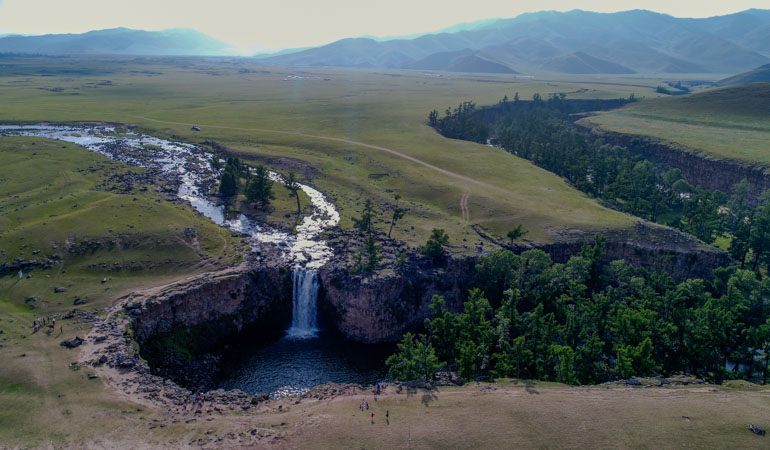
LOCATION: 110 km from Terelj National Park and 180 km from Ulaanbaatar.
Khagiin Khar is a glacial lake in the depths of Khan Khentii Strictly Protected Area in the Baga Khentii Mountain range. This 2.5 km by 1 km lake lies at 1817 m above the sea level, surrounded by coniferous forests. The average depth of the lake is 11 m while it reaches 25 m at its deepest.
The surrounding of the lake remained pristine as the lake is only accessible by foot, horse, or helicopter.
Due to its inaccessibility, some wild animals such as red deer, elk, roebuck, musk deer, brown bear, wolf, lynx, and wolverine have left peacefully in the wild without danger of people.
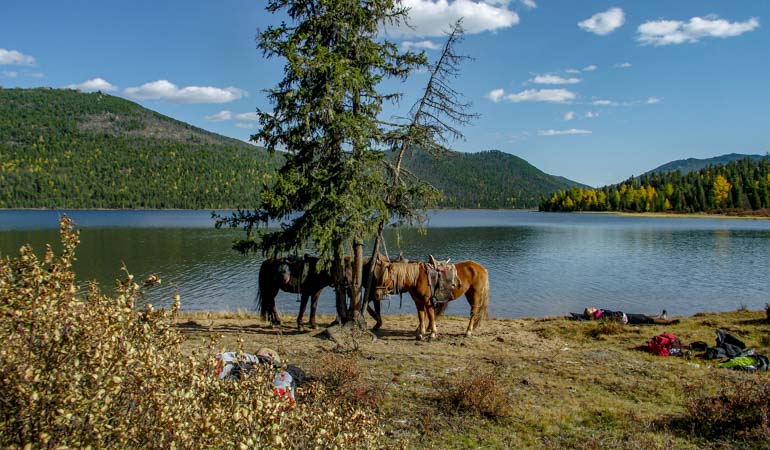
LOCATION: 360 km west of Ulaanbaatar and 25 km from Ugii Nuur town in Arkhangai province.
The freshwater Ugii Lake lies among the mountain steppes and grassy lands of central Mongolia.
Beautiful Ugii Lake is a perfect place for leisure holiday lovers, weekenders, and bird watchers. Regular travelers enjoy traditional dwelling ger stay in the vicinity of the lake, hiking, horse riding, fishing, boating, information center visit, and some common bird watching.
The bird watcher should travel to the wetland in the south of the lake to watch the endangered species of birds such as Dalmatian Pelican, Swan Goose, Baikal Teal, Palla’s Fish Eagle, Lesser Kestrel, Siberian Crane, Great Bustard, and Relict Gull.
There are some 150 species of birds and 14 species of fish recorded around the lake. Ramsar Convention registered Ugii Lake as a protected water ecosystem in 1971.
The lake is not as big as the other lakes in Mongolia, but the largest in the mountain steppes, 7 km by 5 km in size, covers 25 sq. km of area, and 15 m at its deepest.
Locals consider the lake sacred and worship.
Numerous travelers visit Ugii Lake because its location is convenient to reach and combine with other famous attractions and sites as Elsentasakhai semi-desert, Kharkhorin, Tsenkher hot spa, and Tovkhon Monastery.
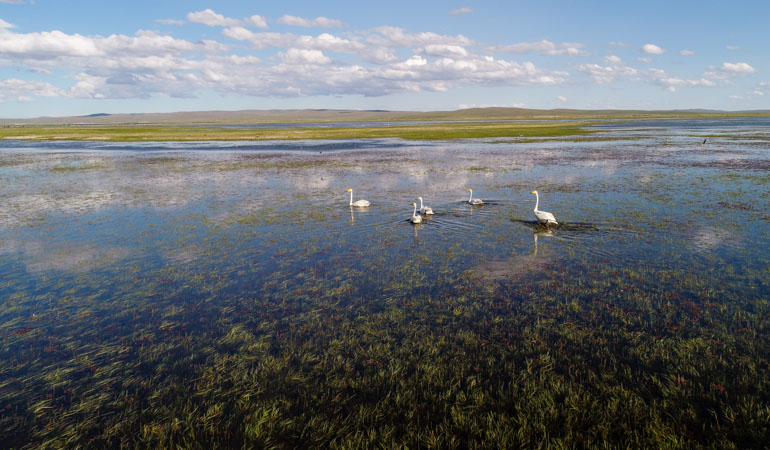
LOCATION: 38 km northeast of Gorkhi Terelj National Park and 140 km northeast of Ulaanbaatar.
The Gunj Temple was built in 1740 by Efu (a title of a man who married with Qing princess)Dondovdorj to commemorate the death of his first wife. There were 4-5 temples in 70m by 40m walls.
Unlike the other temples and monasteries, the communists did not destroy the Gunj/Princess Temple during the 1930s purge. However, it has been neglected over the years and robbed.
The Princess was the youngest of 6 daughters of Qing Emperor Kangxi, who married Dondovdorj in 1697, but she was not a spy as the other Qing princess who married Mongolian noblemen. She married Dondovdorj in love, respected the country and people. The Gunj temple is relatively small and in ruin, though the surrounding nature is pristine.
You can travel this least traveled, non-touristy wild area within a short 1-2 day tour from Ulaanbaatar.
We suggest you combine the tour with Gorkhi Terelj National Park and the gigantic equestrian statue of Genghis Khan.
The suggested activities are hiking, yak cart tour, or yak cart supported trekking, horse riding, and nomad family visit.
There is a ger camp in 18 distance from Gunj temple.
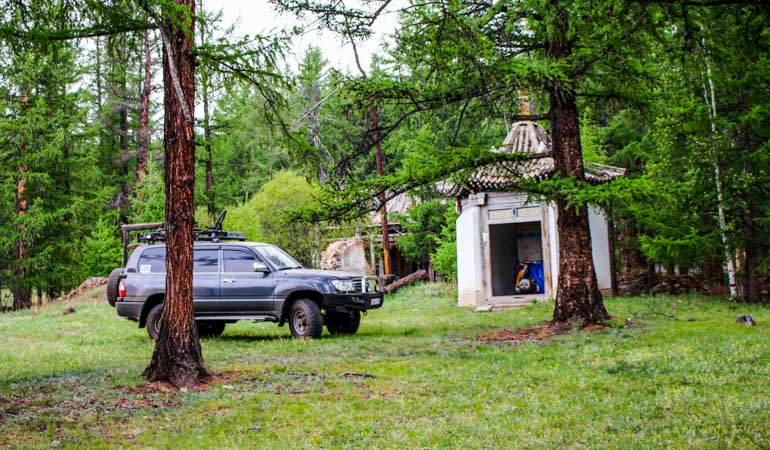
LOCATION: 100 km east of Ulaanbaatar by 80 km paved roads and 20 earth road.
At the 13th-century complex theme park, you will get insight into the lifestyle, art, and crafts of the 13th century.
The complex has 6 different camps and tribes, located at a distance of 1 to3 kilometer from each other.
Relay station or watchtower camp
It is a first camp at the entrance of the complex. A guard dressed in 13th-century clothing will meet you and inspect your ticket. Inside the camp ger are military outfits and weapons.
Craftsman’s camp
Displays some attractive items of craft such as horse equipment, women’s ornaments, jewelry, weapons, and craft tools.
Educational camp
The camp shows an attitude of the 13th-century Mongolian education and literacy.
Herder’s camp
Nomadic forms of transportation and livestock such as horses, camels, and cows surround the nomad settlement. You can experience a short camel and horse riding within the ticket. Inside the ger, you will learn the organization of this nomadic dwelling, dairy product processing methods, and try some dairy products.
Shaman’s camp
3 shamans of different practices host 3 gers. They give information about shamanism and explain the shamanic items. Shamanic rituals are performed depending on the lunar calendar or specific days.
King’s Palace
This is the main camp consists of the ger accommodation and a large ger restaurant, which resembles the 13th-century king’s palace. In the King’s Palace, you will enjoy traditional meals while watching a traditional concert. You can try king and queen costumes for the photo opportunity.
The surrounding area of the park is picturesque with spectacular rugged mountains and open valleys.
As the complex imitates the 13th century, there is no internet, shower, phone reception (there is a G-mobile signal at a certain point), and electricity to disturb you enjoy nature, nomad living, and stargazing. The view is best when you travel in summer.
A day tour to the 13th-century complex takes approximately 7 hours, including lunchtime, or you may combine the trip with the large equestrian statue of Genghis Khan.
Alternatively, you may tour the 13th-century complex overnight.
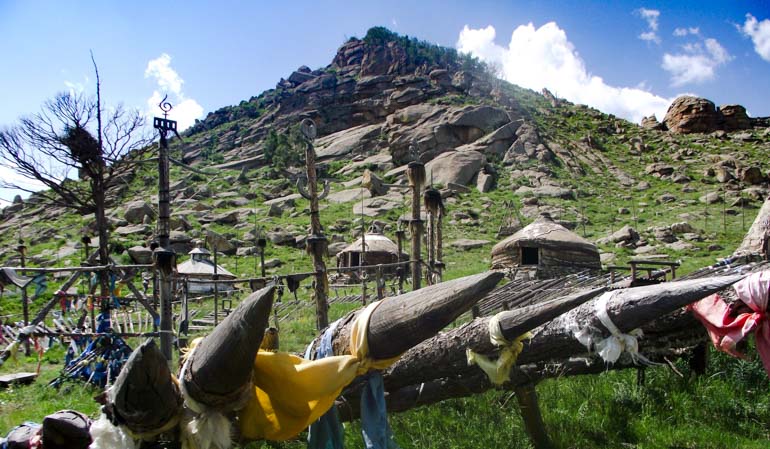
Copyright © 2025. All right reserved. Virgin Nature LLC